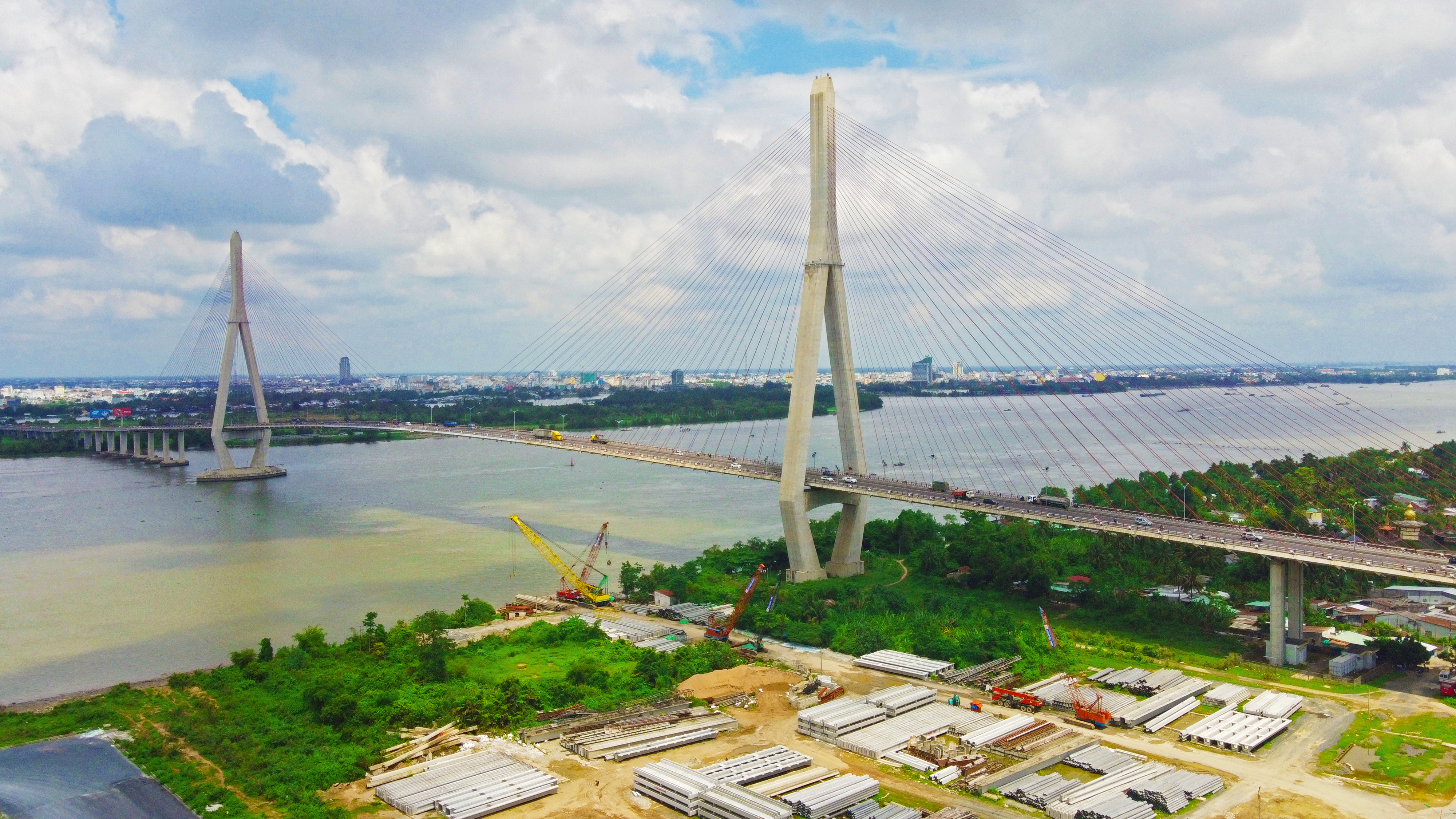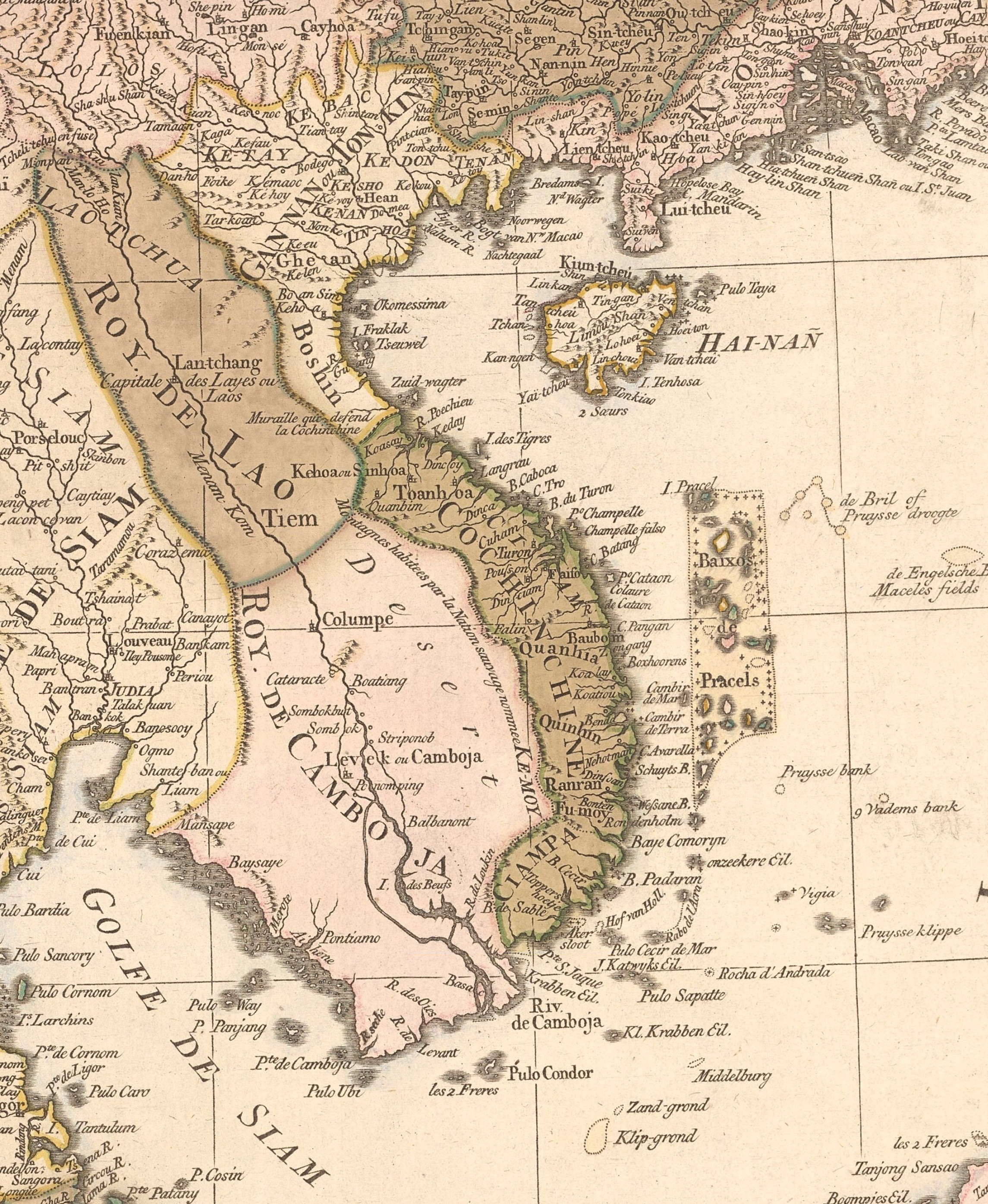|
Principality Of Hà Tiên
The Principality of Hà Tiên (; vi-hantu, 河僊鎮 or 河仙鎮, ''Mueang Phutthai Mat''), or the Hà Tiên Protectorate, was a principality of Chinese settlers ruled by the Mạc (Mo) clan at the Gulf of Thailand, in modern-day southern Vietnam and Cambodia. It was originally ''de facto'' independent, but later became a vassal state of the Siamese Rattanakosin Kingdom (1782–1932), Rattanakosin Kingdom and the Vietnamese Nguyễn dynasty in the 18th and 19th century prior to its annexation by the latter in 1832. Along with Hưng Yên, Phố Hiến, Hội An, and Saigon, Hà Tiên was a major Chinese community center and important hub of Ming dynasty, Ming loyalist networks in premodern Indochina. The name of the principality was variously spelled as ''Hexian Zhen'' (河仙鎮), ''Nangang'' (南港), ''Gangkou'' (港口), ''Bendi'' (本底) or ''Kundama'' (昆大嗎) in Chinese, ''Phutthaimat'' () or ''Banthaimat'' () in Thai, ''Ponthiamas'', ''Pontheaymas'' and ''Pontiano'' in ... [...More Info...] [...Related Items...] OR: [Wikipedia] [Google] [Baidu] |
Nguyễn Lords
The Nguyễn lords (, 主阮; 1558–1777, 1780–1802), also known as the Nguyễn clan (; ), were Nguyễn dynasty's forerunner and a feudal noble clan ruling southern Đại Việt in the Revival Lê dynasty. The Nguyễn lords were members of the House of Nguyễn Phúc. The territory they ruled was known contemporarily as Đàng Trong (Inner Realm) and known by Europeans as the Kingdom of Cochinchina and as Kingdom of Quảng Nam (; ) by Imperial China, in opposition to the Trịnh lords ruling northern Đại Việt as Đàng Ngoài (Outer Realm), known as the "Kingdom of Tonkin" by Europeans and "Kingdom of Annam" (; ) by Imperial China in bilateral diplomacy. They were officially entitled, in Sino-Vietnamese, the ' () in 1744 when lord Nguyễn Phúc Khoát self-proclaimed himself to elevate his status equally to Trịnh lords's title known as the ' (; ). Both Nguyễn and Trịnh clans were ''de jure'' subordinates and fief of the Lê dynasty. However, the ''d ... [...More Info...] [...Related Items...] OR: [Wikipedia] [Google] [Baidu] |
Hưng Yên
Hưng Yên () is a city in the Red River Delta of the Northern Vietnam. It is the old capital of Hưng Yên Province and is a third-graded city according to Vietnam's urban classification table. History Hưng Yên city was originally the expansion of Phố Hiến (Hiến Street), a river port that appeared earliest in the 16th century. Phố Hiến has a position as a place where Sơn Nam garrison's government was located. However, its area was relatively small. It only consists of a public authority, Xích Đằng Literary Temple and a few markets. During several centuries, this location was an important gateway of the commercial platform in Đông Kinh. It was not until the French set a protective regime that Phố Hiến was expanded to Hưng Yên town (thị xã Hưng Yên). Geography Topography According to the 2021 statistical yearbook of the whole Hưng Yên province, Hưng Yên city covers an area of 73,89 km2. Currently, it was divided such as : *6 wards : An T� ... [...More Info...] [...Related Items...] OR: [Wikipedia] [Google] [Baidu] |
Cần Thơ
Cần Thơ () is the List of cities in Vietnam, fourth-largest city in Vietnam, and the largest city along the Mekong Delta region in Vietnam. It is noted for its floating markets, rice paper-making village, and picturesque rural canals. It has a population of around 1,507,187 as of 2024, and is located on the south bank of the Hậu River, a distributary of the Mekong River. In 2007, about 50 people died when the Cần Thơ Bridge Collapse of Cần Thơ Bridge, collapsed, causing Vietnam's worst engineering disaster. In 2011, Cần Thơ International Airport opened. The city is nicknamed the "Mekong Delta, Western Metropolis" (), and is located from Hồ Chí Minh City. History During the Vietnam War, Cần Thơ was the home of the Army of the Republic of Vietnam, ARVN IV Corps capital. The 21st Division (South Vietnam), ARVN 21st division was dedicated to protect the city of Cần Thơ, including the provinces of Chương Thiện (now in Hậu Giang), Bạc Liêu, An Xuyen ... [...More Info...] [...Related Items...] OR: [Wikipedia] [Google] [Baidu] |
Siamese–Vietnamese War (1771–1773)
The Siamese–Vietnamese War (1771–1773) was a war between Siam (modern Thailand) of the Thonburi Kingdom, Thonburi Period in the reign of Taksin, King Taksin and the Nguyễn lords, Nguyễn Lords of Cochinchina or Southern Vietnam. The war also involved Post-Angkor period, Cambodia and the Principality of Hà Tiên, Hà Tiên polity, which were allies of the Nguyen Lord. Background After the Fall of the Ming dynasty, a Cantonese people, Cantonese named Mo Jiu or Mạc Cửu (鄚玖) migrated from Leizhou, Guangdong, Guangdong Province to settle in the Cambodian coastal port town of Bantaey Meas (Khmer language, Khmer:បន្ទាយមាស) or modern Hà Tiên in 1671. Banteay Maes was populated by the native Cambodians and the Chinese traders. Mạc Cửu ran a local gambling den in Banteay Maes and managed to propel himself to the riches. He was granted the rank of ''Oknha'' from the Cambodian king for his wealth. Mạc Cửu and his Cantonese followers built a Chin ... [...More Info...] [...Related Items...] OR: [Wikipedia] [Google] [Baidu] |
Taksin
King Taksin the Great (, , ) or the King of Thonburi (, ; ; Teochew: Dên Chao; 17 April 1734 – 7 April 1782) was the only king of the Thonburi Kingdom that ruled Thailand from 1767 to 1782. He had been an aristocrat in the Ayutthaya Kingdom and then was a major leader during the liberation of Siam from Burmese occupation after the Second Fall of Ayutthaya in 1767, and the subsequent unification of Siam after it fell under various warlords. He established the city of Thonburi as the new capital, as the city of Ayutthaya had been almost completely destroyed by the invaders. His reign was characterized by numerous wars; he fought to repel new Burmese invasions and to subjugate the northern Thai kingdom of Lanna, the Laotian principalities, and threatening Cambodia. Although warfare occupied most of Taksin's reign, he paid a great deal of attention to politics, administration, economy, and the welfare of the country. He promoted trade and fostered relations with foreign ... [...More Info...] [...Related Items...] OR: [Wikipedia] [Google] [Baidu] |
Chao Chui
Chao may refer to: People * Chao (surname), various Chinese surnames (including 晁 and 巢, as well as non-Pinyin spellings) * Zhou (surname) (周), may also be spelled Chao * Zhao (surname) (趙/赵), may also be spelled Chao in Taiwan and some countries/regions in South-East Asia. Places * Chao, Virú, Peru ** Chao District ** Chao Valley * Cerro Chao, or Chao volcano, a lava flow in Chile * Chao Lake, in Hefei, Anhui Province, China * Chao (state), a minor state of the Chinese Bronze Age * Ilhéu Chão, in the Madeira archipelago Other uses * Chao (currency) (鈔), the banknote used in Mongol Yuan Dynasty in China * Chao (''Sonic the Hedgehog''), a fictional species * Chao method, a way of indicating Chinese tones devised by Yuen Ren Chao * Chǎo technique (炒), a Chinese stir frying technique * Chao, part of several Thai royal ranks and titles ** Chao (monarchy), a title of the Lan Na royal family members * Cháo, the Vietnamese version of congee * Chao, a character f ... [...More Info...] [...Related Items...] OR: [Wikipedia] [Google] [Baidu] |
Outey II
Outey II (; 1740–1777) was king of Cambodia from 1758 to 1775. He reigned under the name of Outeyreachea II, Reameathipadei IV or Neareayreachea II. Outey was the oldest son of Prince Outeyreachea (1707–1753) and Princess Peou, a daughter of King Ang Em, which made him heir to both rival branches of the Varman dynasty, since Outey's grandfather was King Ang Tong, who had ruled Cambodia. When Outey was born in 1740, one year after the Vietnamese were expelled by the Siamese army, Chey Chettha's son King Thommo Reachea was ruling Cambodia for the third time in his life, until he died in 1747. Thommo Reachea son and heir was murdered by a brother, the ministers chose a third brother as King, Ang Tong in 1748, but after being attacked by his relative Satha and a Vietnamese army, he fled to Siam. During his exile, the people in Cambodia drove out the Vietnamese once again, and chose Chey Chettha V as King, who after ruling Cambodia for six years, died in 1755, when Outey's gr ... [...More Info...] [...Related Items...] OR: [Wikipedia] [Google] [Baidu] |
Oknha
''Oknha'' (, ) is a Khmer honorific. It has different meanings depending on the period it was used. Linguistics The word means "nobleman" or "lord". The translation of "''Oknha''" is not unanimous. Leaning on the meaning of Vietnamese title "''Quốc công''", some have translated the title of ''oknha'' as "Duke" while some others favour the more mercantile version of Business magnate, tycoon. History ''Oknha'': the royal envoy of the Khmer Empire In premodern times, ''Oknha'' were envoys appointed by the king, who were expected to perform a wide variety of duties, take elaborate oaths of loyalty, and present the monarch with regular gifts. ''Oknha'' was one of the noble titles, above ''Preah'' ( ) and below ''Neak Oknha'' ( ). The term is used as such in modern Khmer inscriptions found in Angkor, such inscription IMA 9 dating back to 1539 and recalling the good deeds of "uk-na Samarasangram". Royal title created by the Oudong monarchy (17th–19th century) The title ''Oknha ... [...More Info...] [...Related Items...] OR: [Wikipedia] [Google] [Baidu] |
Leizhou
Leizhou () is a county-level city in Guangdong Province, China. It is under the jurisdiction of the prefecture-level city of Zhanjiang. The city was formerly known as Haikang County ( postal: ''Hoihong''); it was upgraded into a city in 1994. Geography Leizhou is located at the extreme southwestern end of Guangdong and lies on the Leizhou Peninsula. Transportation *China National Highway 207 Climate Notable People * Mạc Cửu Cửu (, vi-hantu, 鄚玖, ; ''or'' ; 1655– July 18, 1735), also spelled Mok Kui, was an exile from China who founded the Principality of Hà Tiên and ruled as its first monarch. He played a role in the relations between Cambodia and the ... (1655–1731): Founder of the Principality of Hà Tiên. See also * Leizhou dialect References County-level cities in Guangdong Zhanjiang National Famous Historical and Cultural City {{Guangdong-geo-stub ... [...More Info...] [...Related Items...] OR: [Wikipedia] [Google] [Baidu] |
Banteay Meas
Banteay Meas District ( ) is a district located in Kampot Province, in southern Cambodia Cambodia, officially the Kingdom of Cambodia, is a country in Southeast Asia on the Mainland Southeast Asia, Indochinese Peninsula. It is bordered by Thailand to the northwest, Laos to the north, and Vietnam to the east, and has a coastline .... References Districts of Kampot province {{Cambodia-geo-stub ... [...More Info...] [...Related Items...] OR: [Wikipedia] [Google] [Baidu] |




